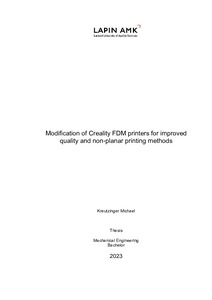Modification of Creality FDM printers for improved quality and non-planar printing methods
Kreutzinger, Michael (2023)
Kreutzinger, Michael
2023
Julkaisun pysyvä osoite on
https://urn.fi/URN:NBN:fi:amk-2023052514360
https://urn.fi/URN:NBN:fi:amk-2023052514360
Tiivistelmä
In the context of this work, it was investigated how non-planar printing could be realised with existing standard FDM 3D printers. On the one hand, the approach of printing only the top layer non-planar and thus obtaining a high-quality surface was investigated. For this purpose, a Linux-based slicer was tested which prints the main part of the model in planar and then, limited by the print head geometry, traces the surface contour.
A further approach was conical slicing, in which a model was first warped along the Z axis, then sliced and finally the G-code transformed back. This slicing method was tested by converting a Creality Ender 3, in which a fourth, rotatable axis with a 45° nozzle was integrated. Both the motherboard and the corresponding software were replaced and extended by a further axis and finally tested.
In order to test the effect of a conversion from a V-roller system to a linear rail system, a Creality CR10 Max was converted. The focus was on improving the accuracy as well as the wear and tear and the printing speed in the long term. In addition, the existing Bowden kit was replaced with a direct drive extruder to investigate its effect on stringing
A further approach was conical slicing, in which a model was first warped along the Z axis, then sliced and finally the G-code transformed back. This slicing method was tested by converting a Creality Ender 3, in which a fourth, rotatable axis with a 45° nozzle was integrated. Both the motherboard and the corresponding software were replaced and extended by a further axis and finally tested.
In order to test the effect of a conversion from a V-roller system to a linear rail system, a Creality CR10 Max was converted. The focus was on improving the accuracy as well as the wear and tear and the printing speed in the long term. In addition, the existing Bowden kit was replaced with a direct drive extruder to investigate its effect on stringing
